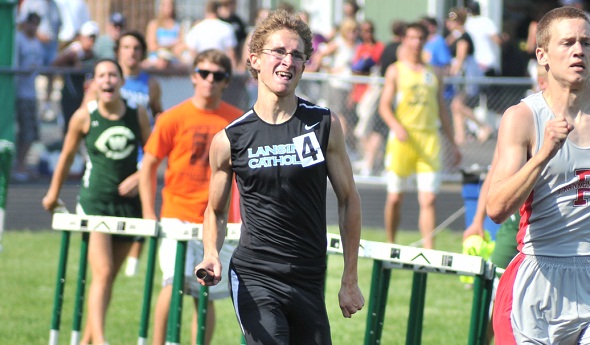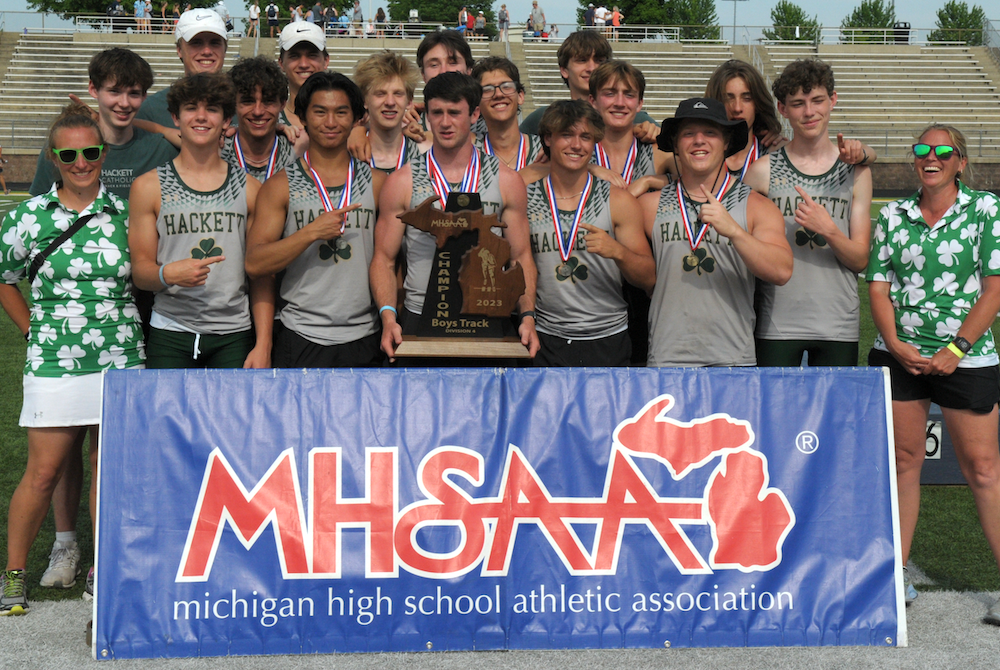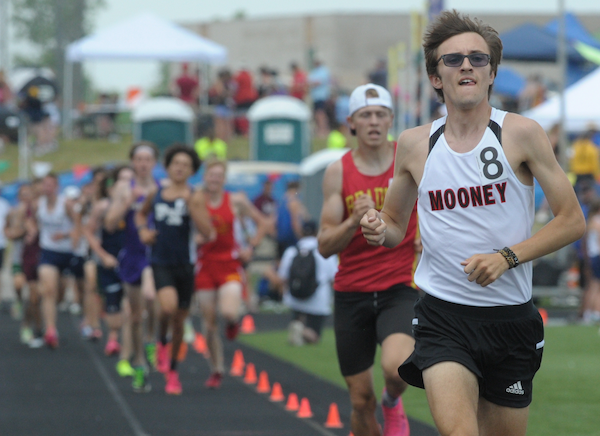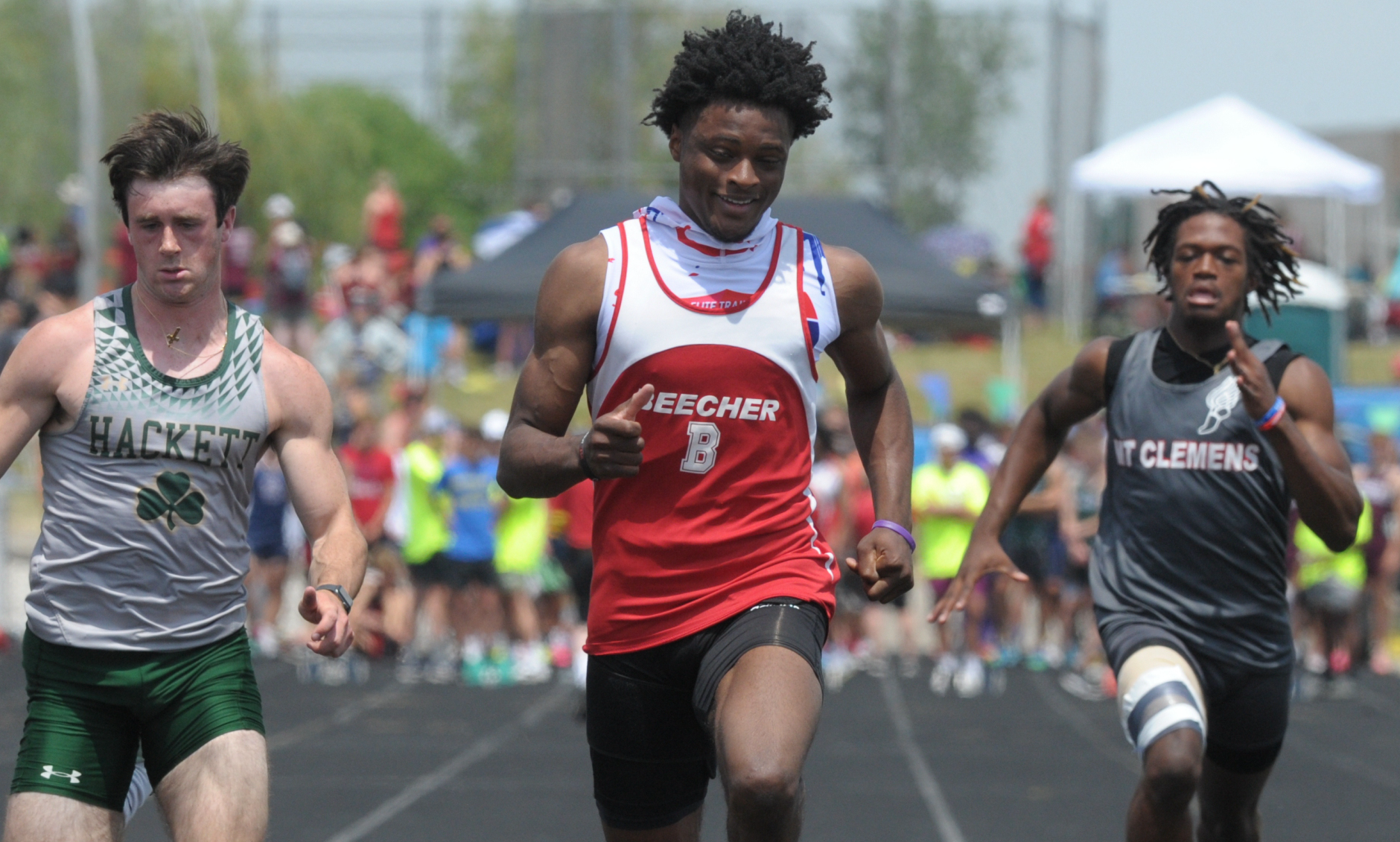
Zingsheim's Story an Award-Winner
May 31, 2012
By Geoff Kimmerly
Second Half editor
Zack Zingsheim’s career highlight is an easy pick.
It was just a few months ago, at Michigan International Speedway, when he stunned even himself by winning the MHSAA Division 3 cross country championship.
He can describe in vivid detail being the last to come out of the chute at the finish, looking into the grandstand and telling himself to always remember the moment. He can see again his teammates further down the chute, chanting his name. The goose bumps he felt. How they jumped the fence, lifted him to their shoulders and carried him off the course.
It was the greatest day he could remember. And it ended with a pie in the face.
“I remember how surreal the moment was,” he said. “Since I was a little kid, I thought it would be so cool to win the state meet for cross country; the atmosphere is so amazing.”
Nearly as amazing is he doesn’t remember the flavor of the pie.
Zingsheim tells a story with the best of them – thanks in part to a keen photographic memory and attention to detail.
But he gets a Second Half High 5 this week because of his status as one of the state’s top high school runners – and what a tale he’s spun over the last year.
Zingsheim has the top-seeded Division 3 time in the 800 meters (1:55.30) heading into Saturday’s Finals at Comstock High School, and also runs on the top-seeded 800, 1,600 and 3,200 relays. He and his teammates won the 800 relay at last season’s Finals, and he has or is part of school records in all four of those races, plus the 400. He’s also the fastest in Cougars cross country history.
Another of his favorite stories to tell explains why.
Diamond in the rough
He remembers seeing the Corunna baseball diamond in the distance. That’s key to this story.
Zingsheim was a freshman in 2009, running the second leg of the 800 relay, and had just taken the baton. His right hip had been feeling tight and then painful over the previous couple of weeks, but he felt great at that point as he glanced ahead and saw the baseball field.
The next step, he felt like he got hit with a baseball square in the right hip. But there was no baseball.
He tried to bring the leg forward, and couldn’t. He dragged his leg the next 100 meters to complete his handoff, and then collapsed.
Zingsheim did see a “flabby piece of bone just laying there.” He started crying. His parents immediately drove him to the hospital as he screamed the lyrics to whatever was on the radio to try to forget the pain. (And yes, he remembered one off the songs: “Boom Boom Pow” by the Black Eyed Peas.)
The flexor muscle that connected his hamstring to his pelvis had torn and taken the top of that part of his pelvic bone with it.
Next came months of therapy and changes. He’d started on the freshman basketball team, but decided to stop that sport and focus on running. Still, he couldn’t get in shape that summer because he couldn’t put in the miles, and his sophomore cross country season wasn’t what he’d wanted – until he ran a personal best late in the season and got a needed confidence boost.
“There’s something so special about being able to run so hard and seeing hard work come to fruition on the course or the track,” Zingsheim said. “And especially, seeing how far I had to come. I wanted to see what kind of runner I could become if I put all that work in.”
His 1,600 relay finished eighth at the 2010 Division 3 Finals, another turning point. A year later, Lansing Catholic coach Tim Simpson needed a fill-in on the 800 relay. The date was April 13, 2011 – a day shy of two years since he’d suffered the pelvic break. “I’ve never been so nervous for another race,” he said. But the Cougars set a school record, and he’s been on that relay since.
A long road traveled
“He’s come a long way, but he’s always had that ability,” Simpson said. “He ran 50-70 miles a week during the summer. He reads about the top runners, follows it, so he know what they’re doing, what you’re supposed to do if you’re going to be good.”
There’s always an eye on the details; Zingsheim’s got a reputation among his classmates as the guy who always is last to turn in his tests. He gets done quickly, but spends the rest of the period double and triple-checking his answers to make sure everything is right.
There are plenty of other stories, of course. Like how he and his talented classmates – Lansing Catholic’s senior boys also played in the Division 5 Football Final in the fall – split up during middle school into football teams that stayed the same for months and turned into fierce rivalries. (He played receiver.)
He’s earned the story-teller role in his family too; at gatherings he’s often the go-to guy for a “quirky” or “goofy” family tale.
But the stories he’ll be most proud to be part of are those that get passed down to Lansing Catholic runners after him.
Zingsheim was in first grade when his brother Brandon was a senior on the cross country and track teams and began the Cougars’ tradition of saying a “Hail Mary” and chanting “Hey Cougars, what we going to do?” Zack is among those who now lead that rally.
Lansing Catholic had outstanding runners before Zingsheim. But with him and a strong group of individuals including distance seniors Jimmy Hicks (who will walk-on at the University of Georgia), Austin Winter and Joe Marrah, they could cap their careers with the team’s first MHSAA championship.
“What I really wanted to do by the time my tenure was done was lay a foundation. Build the program; do things the right way,” Zingsheim said. “I wanted to teach guys what it means to be an LCC runner.
“The last four years, we’ve really been able to build that program. … And I’m so excited to see where the program is going the next couple of years.”
Click to read more about Zingsheim's inspirations and aspirations.
PHOTO: Lansing Catholic's Zack Zingsheim was part of the championship-winning 800 relay at last season's Division 3 Final.

Thrower Claims Lone Individual Title to Lead Hackett to Team 3-Peat
By
Tom Lang
Special for MHSAA.com
June 3, 2023
Kalamazoo Hackett Catholic Prep just keeps winning and winning.
This time the Irish took home their fourth title in the last five Lower Peninsula Division 4 Track & Field Finals, on Saturday at Hudsonville.
Hackett’s only individual title was taken by discus winner Nathan Buchmann, a senior, who was fine knowing he was the shortest in stature among all the sizable competitors.
“In the offseason after football I worked out every day, working towards this goal,” he said after getting his medal. “I would say this takes 80 percent technique and 20 percent strength to throw the discus. So, length can help but if you have good technique and are really strong, that will play into it.
“I think we are very balanced throughout the meet today,” he said about teammates that scored points in finishes other than first place. “We have 13 guys here today, and we have people in a lot of the races. But I do not run; I have too short of legs to be a fast runner,” he said with a chuckle.
Buchmann had to work through a hip injury to compete this spring.
“I think the setbacks are what make you strong,” he said. “You can either give up through the setbacks or push forward and become better.”
 Coach Charissa Dean agreed.
Coach Charissa Dean agreed.
“The kids have big hearts,” she said after all the points were totaled and the Irish were on top once again, with 53. “They worked hard. They had a lot of potential when we started the season. And we had a lot of drive to put in the work, and we are happy the results came out the way they did.”
Reading was runner-up at 47 points, followed by Wyoming Potter’s House Christian with 42, then Fowler and Flint Beecher each with 37 points.
Senior Lezawe “Moses” Osterink, of Potter’s House Christian, placed second in 1,600 but took the 3,200 title as defending champ of both. He dominated the latter by lapping the field with a final lap kick that resembled more of a superhero speedster.
“Nobody really took it out that hard at the start,” he said. “There was a freshman (Marek Butkiewicz of Hackett) that tried to get the pace going quick, but me and Dakota (Dykhuis of Montabella) just kind of sat back and gradually pulled him through.
“We took it gradually, and I was just relying that I could kick.”
Kick did he ever. The trio were neck and neck the majority of the race in a grouping ahead of the pack.
“With 400 to go I just tried to go all out,” Osterink said. “I had a lot more left than I thought and I was pleased with the win. Not really the time, but that doesn’t matter, especially this hot out.”
The overall meet was in the low 90s/high 80s heat and searing sun all day. So, race officials allowed the unique opportunity for coaches to spray the runners with water and give them water bottles.
“It was very weird because I’ve never taken water to drink while I’m running, so I didn’t know how that would feel,” Osterink said. “And they were spraying us and hitting us in the face. It was kind of fun.”
Junior Tyler Lenn of Marine City Cardinal Mooney defeated Osterink at his own game in the 1,600.
“I’m feeling great,” Lenn said after grabbing the medal. “I said to a newspaper after one of my races (during the season) I was right where I wanted to be. This has been a long rebuilding process for me since an injury back in the fall, and I set a pretty high goal the day the injury happened. I was telling myself I needed to fulfill what I said I would do at the beginning of last cross country season. And that is what I did today.”
Lenn suffered an ankle sprain from a misstep that turned worse because he kept running through the season on it.
“Coming back from that was pretty tough, but I wouldn’t have it any other way,” he said.  “Perseverance; I said from the beginning what I was going to do. I kept my eye on that target, and no matter the circumstances life threw at me, that I was going to make it happen and I am a man of my word.”
“Perseverance; I said from the beginning what I was going to do. I kept my eye on that target, and no matter the circumstances life threw at me, that I was going to make it happen and I am a man of my word.”
Jaylin Townsend, a senior from Flint Beecher, dominated the short races. He won the 100 dash (10.67) and 200 dash at 22 seconds flat. It was his third 100 win at a Finals.
“I put in a lot of work; I had to three-peat,” he said after the 100. “There’s a lot of great competition here, so I knew I had to come out and run my best.”
Concord in the 400 (43.72), Buckley in the 800 (1:30.76) and 1,600 (3:29.13) and Potter’s House in the 3,200 (8:14.18) were relay champs Saturday. Reading’s Tayshawn Bester won the 110 hurdles (15.13), and Athens’ Landen Bennett won the 300 (39.85). Caseville’s Nathan Feltner won the 400 (50.76), and Vestaburg’s Owen Patton claimed the 800 (1:55.11).
Fruitport Calvary Christian’s Bradley Richards won the high jump (6-10), and Peck’s Alex Affer won the long jump (23-4). McBain Northern Michigan Christian’s Isaac Bowden was first in pole vault (13-0), and Brown City’s Kyle Affer won shot put (49-2).
PHOTOS (Top) Kalamazoo Hackett Catholic Prep celebrates its third-straight LPD4 title Saturday. (Middle) Cardinal Mooney's Tyler Lenn, far right, sets the pace in the 1,600. (Below) Flint Beecher's Jaylin Townsend, middle, crosses the finish first for one of his two sprint championships. (Photos by Ken Swart/RunMichigan.com.)

